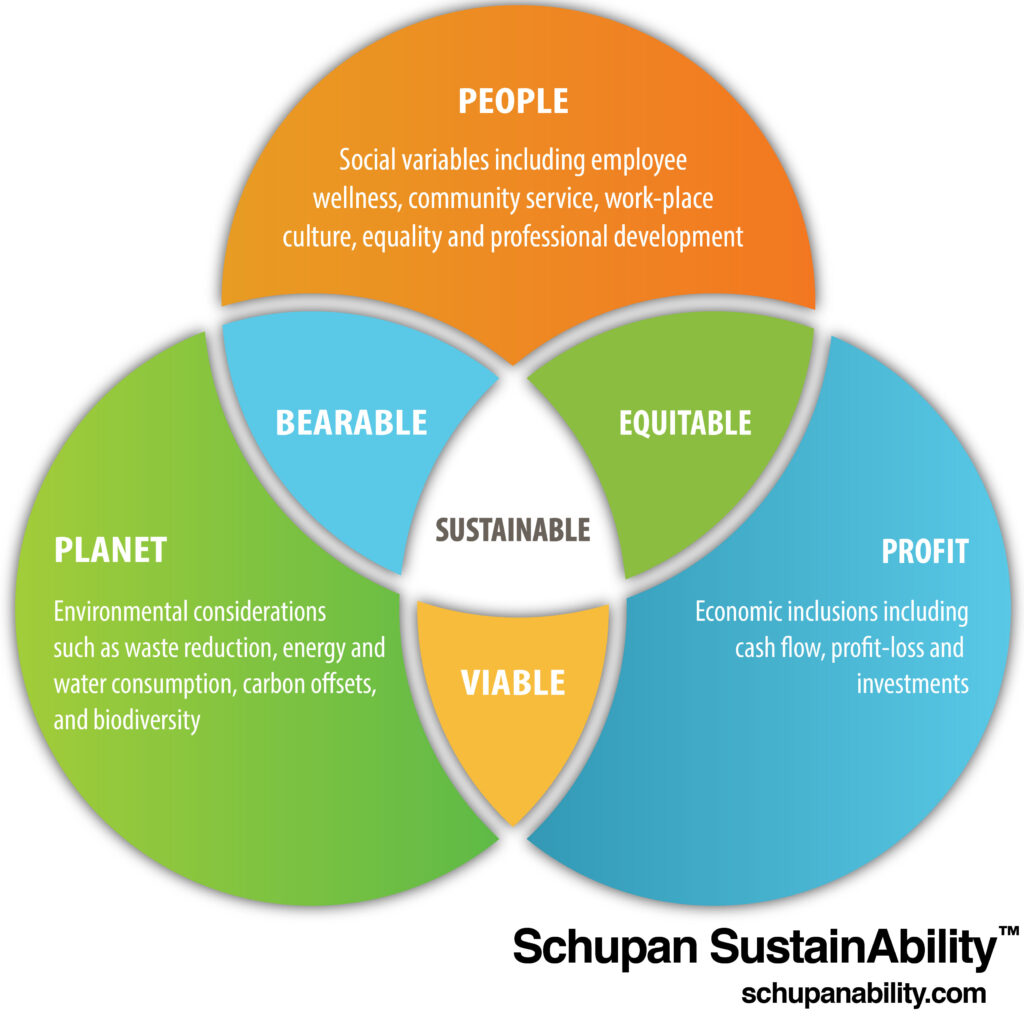You may have visited a business website recently and seen a page for “Social Responsibility” or “Corporate Citizenship.” You may have even seen a link to a company’s “Sustainability Report” or “Corporate Social Responsibility” report.
In recent years, businesses have taken a greater interest in focusing on, strengthening and communicating their sustainability strategies. Here, sustainability means economic, social and environmental sustainability (or people, planet, profit) – often times referred to as the triple bottom line. In general terms, it means operating a business responsibly, in benefit of not only our bottom line, the owner’s pocket books and your customers, but for the benefit of your employees, your community and your environment.
Corporate responsibility is more than just a checklist of items to achieve, it’s how you conduct business, and more importantly, your business culture.
What is the triple bottom line?

Social – When examining your social areas, think broadly on how your company and its products or services impacts people and communities. Do you have diversity and inclusions strategies in your human resources department? Do you invest in the development of your employees through trainings and mentorships? Do you have an employee wellness program?
Economic – Here, economic means more than just being profitable, it’s about how, where, and why you choose to invest your money. Do you provide charitable donations to your community? Are your business investments sustainable and responsible? Are you handling your funds ethically? Are you reinvesting in your employees and your business growth?
Environmental – What are your environmental impacts from operating your business? Are you mitigating your carbon footprint? Are you recycling at your office buildings? Are you sourcing materials responsibly and sustainably? Are you positively contributing to the health of our environment?
How is the triple bottom line measured?
There are some companies and consultants who will grade your CSR, but if you cannot afford their services, there is no official grading scale to follow. However, we recommend some general guidelines to keep in mind.
- Stay in balance. In order to stay in business, you must be making a profit. There are times when implementing CSR strategies will cost you money, with no direct return on investment that can be measured in dollars and cents. Do not invest too heavily in one area of your CSR strategy and sacrifice financially if you are not certain you can achieve a net positive ROI (either in real money or soft money value).
- Be honest and objective. When starting your CSR journey, you may discover some unsettling truths or data points. You may have thought your workforce was much more diverse than what it actually is. You may think that your product doesn’t negatively impact the environment, but it does. Be open to hearing these unsettling truths and be open to making changes to enhance your company and build your CSR.
- There is not “one answer.” We often hear, “So what is the solution?” The answer to this question will be different for every business. One company’s solution may not be right for another. It’s important to determine your end goals, determine your starting point and create a solution crafted specifically for your journey from your starting point to meeting your end goals.
How much does a CSR investment cost?
As with almost any business strategy and investment, there will be out of pocket expenses. There is a common held belief that CSR will cost you money. While this is true, there are many ways to design your strategy to actually be profitable.
We have found the following to the most common expenses:
- Labor. It takes people to gather data, information and create a plan. You may have to hire someone specifically for the job on a full-time or part-time basis. You may hire a consultant or firm to perform the work. Or you may allocate part of someone’s job responsibilities to CSR. As a result, there are direct and in-direct expenses involved that will need to be accounted for.
- Program development. Developing your CSR strategy means developing a way to easily collect information and data and to successfully analyze that information and data. Expenses are common in this area as software changes, training workshops, rewriting of procedures, and development of that process most often result in expenses.
- Change of Vendors/Suppliers. Procurement could have a measurable impact on your strategy. You may discover vendors who use raw materials in their products that are sourced from less than ethical sources. You may decide to switch to a more local vendor. You may decide to change to a supplier whose business values more closely align with yours. All of these changes often result in direct or indirect expenses.
Is it worth it?
Consumers, and our society in general, are looking for more transparency in the companies they interact with on a daily basis. A recent study found that 91% of respondents expect businesses to operate in a sustainable and responsible way. Another 84% said they actively seek our products from reputable and responsible companies.
Shifting your business to a more sustainable and responsible model can have many benefits:
- Brand strength and public awareness
- Increased consumer/customer engagement
- Cost savings
- Increased employee recruitment, retention and engagement
- Competitive edge
Adopting corporate responsibility strategies is a long term commitment that requires time, money, resources and energy. Success can be achieved for all types of businesses, all budgets, and all goals and objectives.
If you need help understanding where to start, are confused on your options, or would like to bring a Schupan professional on staff to help you on your journey, feel free to contact us!





